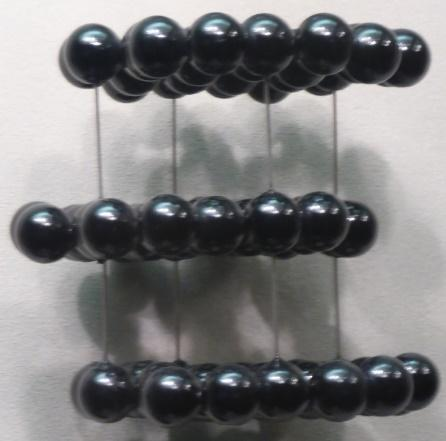
The carbon-carbon bond length in graphite is
A.$1.34A^\circ $
B.$1.54A^\circ $
C.$1.42A^\circ $
D.$1.20A^\circ $
Answer
570.3k+ views
Hint: The usual $\,C - C\,$ single bond length is $1.54A^\circ $. The carbon-carbon bond length in graphite will be less than this usual bond length due to some reasons which will be discussed further in this solution. Graphite is a hexagonal layered structure in which each carbon has $s{p^2}$ hybridization.
Complete step by step answer:
The actual $\,C - C\,$ single bond has a length of $1.54A^\circ $ but in graphite each carbon atom is bonded to three other carbon atoms that form layers in a hexagonal manner.
Now, you might wonder why its bond length is not the same as a single $\,C - C\,$ bond, the answer is that each carbon in graphite has a non-bonded electron which can delocalize through the structure. The hybridization of carbon in graphite is $s{p^2}$ so one $\,p\,$ orbital is available for the delocalization of electrons. So, the bond length will be less than that of usual $\,C - C\,$ single bond $\,(1.54A^\circ )\,$ and becomes $1.42A^\circ $.
So, the right option is C that is $1.42A^\circ $.
Additional information:
The delocalized electron allows a free movement of electrons through the entire structure which makes it able to conduct electricity. So graphite is a good conductor. And also the layers in graphite structure can slide over due to its weak forces of attraction. This makes graphite a good lubricant because of its slipping nature.
The graphite structure is as follows,

Note:
Note that the bond length of diamond is $1.54A^\circ $ which is a usual $\,C - C\,$ single bond length. Here, in graphite due to delocalization it gets decreased, So, don’t be confused with the two values. And $1.34A^\circ $ is the $\,C = C\,$ double bond length so the real answer will be also more than this value.
Complete step by step answer:
The actual $\,C - C\,$ single bond has a length of $1.54A^\circ $ but in graphite each carbon atom is bonded to three other carbon atoms that form layers in a hexagonal manner.
Now, you might wonder why its bond length is not the same as a single $\,C - C\,$ bond, the answer is that each carbon in graphite has a non-bonded electron which can delocalize through the structure. The hybridization of carbon in graphite is $s{p^2}$ so one $\,p\,$ orbital is available for the delocalization of electrons. So, the bond length will be less than that of usual $\,C - C\,$ single bond $\,(1.54A^\circ )\,$ and becomes $1.42A^\circ $.
So, the right option is C that is $1.42A^\circ $.
Additional information:
The delocalized electron allows a free movement of electrons through the entire structure which makes it able to conduct electricity. So graphite is a good conductor. And also the layers in graphite structure can slide over due to its weak forces of attraction. This makes graphite a good lubricant because of its slipping nature.
The graphite structure is as follows,

Note:
Note that the bond length of diamond is $1.54A^\circ $ which is a usual $\,C - C\,$ single bond length. Here, in graphite due to delocalization it gets decreased, So, don’t be confused with the two values. And $1.34A^\circ $ is the $\,C = C\,$ double bond length so the real answer will be also more than this value.
Recently Updated Pages
A man running at a speed 5 ms is viewed in the side class 12 physics CBSE

State and explain Hardy Weinbergs Principle class 12 biology CBSE

Which of the following statements is wrong a Amnion class 12 biology CBSE

Two Planoconcave lenses 1 and 2 of glass of refractive class 12 physics CBSE

The compound 2 methyl 2 butene on reaction with NaIO4 class 12 chemistry CBSE

Bacterial cell wall is made up of A Cellulose B Hemicellulose class 12 biology CBSE

Trending doubts
What are the major means of transport Explain each class 12 social science CBSE

Which are the Top 10 Largest Countries of the World?

Explain sex determination in humans with line diag class 12 biology CBSE

Draw a labelled sketch of the human eye class 12 physics CBSE

How much time does it take to bleed after eating p class 12 biology CBSE

Suicide bags of cells are aEndoplasmic reticulum bLysosome class 12 biology CBSE




